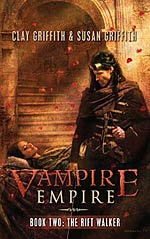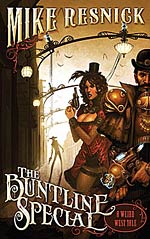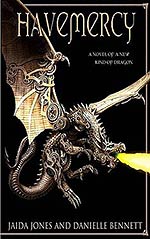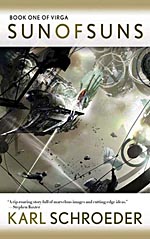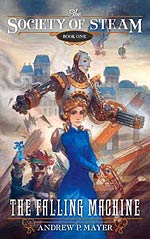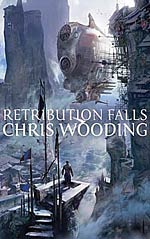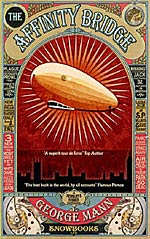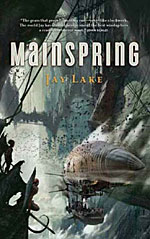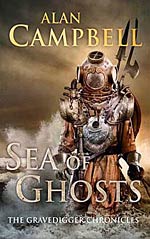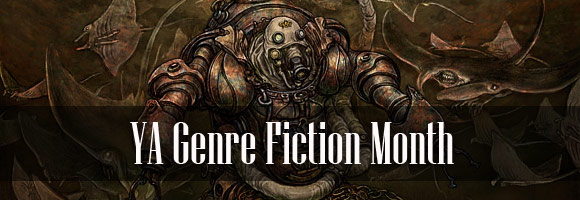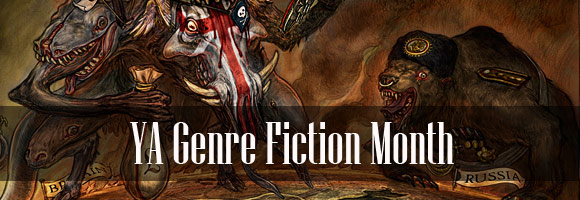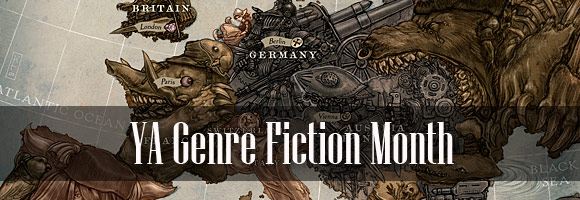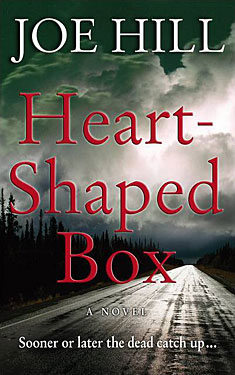Steampunk Books and Machine Age Lamps
 OK, whatever you think of the steampunk sub-genre you have to admit this lamp is freakin’ awesome. And if you are a steampunk fan what better accessory to have in your home?
OK, whatever you think of the steampunk sub-genre you have to admit this lamp is freakin’ awesome. And if you are a steampunk fan what better accessory to have in your home?
This lamp comes from Machine Age Lamps and they have a plethora of options for you to choose from including custom lamps built to your specifications. Each sculptural lamp is one of a kind, signed and numbered and all the gauges and gears are real antiques. Beautiful. I’ve spent a good half hour lusting over these lamps and thought you might like to see them too.
Of course, once you get your funky-awesome new lamp you’ll want something to read under it. Here is a selection of steampunk books for you to enjoy. With everything from vampires to cowboys to Victorian spies to dragons, and even a Dyson sphere for good measure, there is something here for just about everyone.
What steampunk books have you read? Do you have any recommendations for the uninitiated?
Making Coffee the Steampunk Way
Finally, the steampunk revolution produces something useful!
WoGF Review: Soulless by Gail Carriger
 Tanya F. (metalorchid), has been a fan of sci-fi since childhood, a love that kicked off with Ray Bradbury’s The Martian Chronicles. She enjoys plots that involve time travel and alternate histories, but also can’t resist a lengthy, world weaving fantasy epic, or a well crafted short horror story.
Tanya F. (metalorchid), has been a fan of sci-fi since childhood, a love that kicked off with Ray Bradbury’s The Martian Chronicles. She enjoys plots that involve time travel and alternate histories, but also can’t resist a lengthy, world weaving fantasy epic, or a well crafted short horror story.
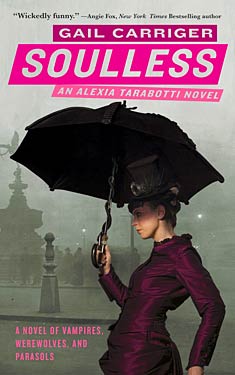 Considering that this is my first book read and reviewed for the 2013 Women of Genre Fiction challenge, I feel a twinge of regret that I’m starting off on a low note, especially since so many people have raved about the Parasol Protectorate series and I’ve been intrigued by the cover image of the woman in purple taffeta, wearing a determined expression as she makes her way through foggy London. (Kudos, cover designer!)
Considering that this is my first book read and reviewed for the 2013 Women of Genre Fiction challenge, I feel a twinge of regret that I’m starting off on a low note, especially since so many people have raved about the Parasol Protectorate series and I’ve been intrigued by the cover image of the woman in purple taffeta, wearing a determined expression as she makes her way through foggy London. (Kudos, cover designer!)
The chief problem I found with Soulless is that it doesn’t quite know what it is. The story of the titular “soulless” protagonist, the quick witted and fiercely independent “spinster” Alexia Tarabotti, weaves elements of Gothic mystery, steampunk, classic (and supernatural) romance, and humor. But, unlike the theory of equilibrium discussed in certain detail by some scientists in the novel, Soulless doesn’t actually strike a balance among all its influences.
For starters, there are numerous repetitive, intended as comedic, allusions to Alexia’s Italian physique and temperament that really start to wear thin. There are also more than a few instances where characters react to their situations with clever little quips that aren’t actually spoken out loud. A lot of these details, which maybe I picked up on because I tend to dislike repetitive humor, seem to present a constant effort on Carriger‘s part to make us remember that these characters are clever, oh so clever! And interesting! And complex! It’s a little too much telling and not enough showing.
WoGF Review: Mechanique by Genevieve Valentine
 Leslie goes by L at omphaloskepsis, a place made to write about reading books and film outside the University classroom, an excuse made to write differently than the usual review blog. She loves creative and intelligent storytellers, words involving the letter v, and knee socks. After noticing she has yet to read nearly enough Sci-Fi or Fantasy of the grown-up variety, she found herself at WWEnd in pursuit of new-to-her female authors.
Leslie goes by L at omphaloskepsis, a place made to write about reading books and film outside the University classroom, an excuse made to write differently than the usual review blog. She loves creative and intelligent storytellers, words involving the letter v, and knee socks. After noticing she has yet to read nearly enough Sci-Fi or Fantasy of the grown-up variety, she found herself at WWEnd in pursuit of new-to-her female authors.
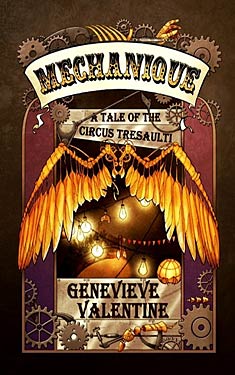 Of note: I am going to exorcise some demons right off the bat, afterward you will find that I actually did enjoy Genevieve Valentine‘s Mechanique.
Of note: I am going to exorcise some demons right off the bat, afterward you will find that I actually did enjoy Genevieve Valentine‘s Mechanique.
Beginning Mechanique I wondered what I had gotten myself into. It was not the short chapters that exchanged narrators, shifted person (1st, 2nd, or 3rd), and moved in and out of time. For the first hundred pages read and often set aside for life-interruptions, I mentioned aloud some form of: It’s like a short story that has been stretched and contorted rather painfully into a novel. It’s like myself with the long jokes, getting parts out of order or forgetting something key and attempting to restart or go back and Sean is trying not to show his impatience, while N is rubbing her temples at the clumsy world-building. Mechanique had me rubbing my temples. I could come up with some clever literary explication about how the chapters’ movement and their disjuncture mimic in form the renderings of a travelling circus through a devastated landscape. But all I could think was, will this smooth out?
The skirting of a secret via sly reference from lip corners and oblique cuts of the eye can be tantalizing but I can only take so many had I only noticed-type asides. I love non-settings and characters made up of context as much as the base coat of an adverb-adjective-noun, and imagery so precise as to lay the page bare. Bird was fairly featureless but for the reactions people had to her. I was working to form her out of negative space. It was exhausting, in part because she wasn’t the only one.* I (lover of the parenthetical) wondered what the deal was with all the parentheticals. Some could’ve been footnoted if not excised altogether but for the idea that they are yet not an aside of the narrator-of-the-chapter. I was tripping over them. They fit and yet not. They were metal bones, inorganic among the easier flow of text; only sometimes they didn’t make their aerialist lighter.
YA Genre Fiction Month: Goliath
Guest Blogger, Allie McCarn, reviews science fiction and fantasy books on her blog Tethyan Books which we featured in a previous post: Five SF/F Book Blogs Worth Reading. She has already contributed many great book reviews to WWEnd and has generously volunteered to write some periodic reviews for our blog. Be sure to check out her site and let her know you found her here.
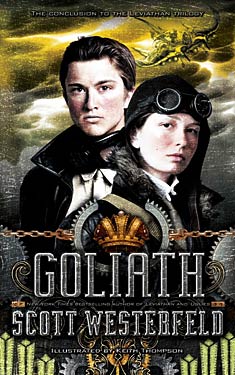 Goliath by Scott Westerfeld
Goliath by Scott Westerfeld
Published: Simon Pulse, 2011
Series: Leviathan Series: Book 3
**Spoiler Alert: I’ve been trying to keep clear of spoiling plot points, but, given that this novel has only been out for a couple of months, it might be a good idea to stop here if you don’t want to be spoiled.
The Book:
"Alek and Deryn may have helped resolve the situation with the Ottoman Empire, but World War I is still escalating. Alek is determined that it is his destiny to end the war, since it was his parents’ deaths started it. However, he’s stuck aboard the Leviathan, which is heading further and further from the heart of the conflict, for reasons no one seems inclined to explain to him.
Deryn’s secret—that she is a woman—is getting harder to keep, particularly now that she has fallen in love with her best friend Alek. She feels certain they could never be together, since he’s the heir to the Austro-Hungarian Empire and she’s a cross-dressing soldier. What she doesn’t know is how Alek will react if he ever learns the truth.
As the course of the Leviathan is diverted through Siberia, Japan, Mexico, and finally to New York City, Deryn and Alek will encounter new dangers, new people, and new hopes for an end to the war!” ~Allie
This is my final review for WWend’s YA Genre Fiction Month. Once again, Goliath picks up right where Behemoth left off, and the first two novels are necessary reading before picking this one up. In most series, I can pick out the stronger and weaker installments, but the novels in the Leviathan trilogy are of remarkably consistent quality. Westerfeld has crafted an even, continuously exciting trilogy that has now come to a very satisfying conclusion.
My Thoughts:
As in the case of the previous two volumes, Goliath is packed with many of Keith Thompson’s wonderful illustrations like the header image above. These are particularly good for showing off the many creative steam-powered machines and fabricated animals that Deryn and Alek encounter on their travels. This time around, the Leviathan airship journeys through many exotic locations, though none of them are nearly as fleshed out as Westerfeld’s Istanbul. While there’s still plenty of action, this is more of a character-oriented book than the previous two. It feels as though it is more focused on Alek and Deryn’s personal stories, though they are still caught up in dramatic historical events.
Aside from the continuing cast aboard the Leviathan, a handful of characters from earlier in the story also make appearances in Goliath. The ‘perspicacious lorises’ from Behemoth are still around, and I feel like I can comment on their role in the story now. While the lorises are quite adorable, in pictures and in actions, they seem to exist solely to point out important clues to the characters (and readers). Considering they were Dr. Barlow’s life work, I had hoped that there would be something more to them. The size of the novel’s cast also swells from the addition of many new characters, some of which are based on historical figures. Though it’s neat to see fictional representations of well-known people from history, I was a little concerned by the strong negative characterization of a certain famously eccentric scientist. I hope that younger readers will understand that while these characters are based on real people, a fair amount of artistic liberty is taken in their portrayal.
I think Goliath handles the budding romance between Deryn and Alek much more skillfully than the previous volume. The original ‘falling in love’ of Deryn seemed abrupt, but the development of their relationship seemed much more natural in Goliath. Deryn’s constant angsting about her and Alek’s relative social status got a little old, but I can’t claim that her obsessing isn’t realistic for someone caught in the grips of first love. I think the story involving Deryn’s secret gender stretched credulity a bit, but I was mostly willing to just go along with the ride. While their romance took a much larger role in this novel, there’s still quite a bit more to the story. Throughout their adventures, I enjoyed watching Alek and Deryn try to make sense of the chaotic world and their places in it.
I’m not aware of any way of connecting Thomas Hobbes to the title Goliath, so I’m going a little further back in time with this title. The obvious reference is to the biblical story of David and Goliath. However, I think Goliath has more to say than the usual statements about a small hero defeating a giant enemy through faith and intelligence. I think Goliath was intended to provoke discussions about morality of the David/Goliath situation. If it will end a war, is it moral to kill someone, as David did Goliath? If by violence, or threat of violence, you can protect the people you love and bring about peace, does that make your actions acceptable? Westerfeld does not provide a simple answer, but these are interesting questions to discuss against the events of Goliath.
My Rating: 4/5:
Goliath is consistent with the high level of quality I have come to expect from Scott Westerfeld’s young adult novels. Deryn and Alek continue their adventures on the Leviathan, traveling to new and exciting locations. Many characters, new and old, show up along the way, and some of them are based on actual people. Goliath deals both with the small-scale story of Deryn and Alek’s personal troubles and secrets, and the large-scale story of attempting to end World War I. I was pleased that Westerfeld did not choose, in the end, to give his readers an unrealistically happy ending. Overall, I think this was a highly satisfying conclusion to the Leviathan trilogy.
YA Genre Fiction Month: Behemoth
Guest Blogger, Allie McCarn, reviews science fiction and fantasy books on her blog Tethyan Books which we featured in a previous post: Five SF/F Book Blogs Worth Reading. She has already contributed many great book reviews to WWEnd and has generously volunteered to write some periodic reviews for our blog. Be sure to check out her site and let her know you found her here.
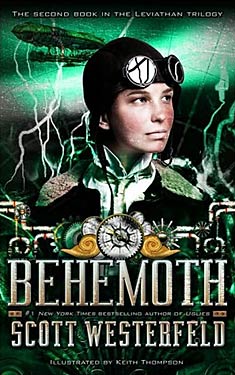 Behemoth by Scott Westerfeld
Behemoth by Scott Westerfeld
Published: Simon Pulse, 2010
Series: Leviathan Series: Book 2
Award Nominations: Locus Young Adult Award 2011
The Book:
"It is near the beginning of World War I, and the situation in Europe is spiraling out of control. After the assassination of Archduke Franz Ferdinand, battle lines have been drawn between ‘Clanker’ powers—whose technology involves mostly heavy machinery—and the ‘Darwinists’—who rely on fabricated animals. A wild card in this scenario is the Ottoman Empire, which is currently maintaining fragile neutrality. After Churchill ‘borrows’ a warship bought by the Ottomans, diplomatic relations between the Ottomans and the Darwinists begin to worsen.
It is into this situation that the Darwinist Leviathan airship soars, carrying with it the adventurous midshipman ‘Dylan’ Sharp and the fugitive Clanker aristocrat Aleksandar. Dylan and Alek have forged a close friendship, though they both hold secrets. Alek may be the heir to the Austro-Hungarian Empire, and ‘Dylan’ is actually Deryn, a young woman who has joined the military in disguise. They’re going to have to work together to navigate the dangerous cultural and political tangle of the Ottoman capital of Istanbul!” ~Allie
This is the second of my reviews for WWEnd’s YA Genre Fiction Month. (See my review for Leviathan here.) Behemoth picks up right where Leviathan left off, so it’s absolutely necessary to read the series in order. Thus far, I have been happy with the way each novel concludes its individual arc, while still continuing the overarching story of the series.
On a side note, Westerfeld takes some slightly more subtle liberties with established history in Behemoth. I could see some readers being concerned that the trilogy’s alternate history may obscure actual history for younger readers. I don’t think this will be a problem, however, as Westerfeld helpfully includes an afterword in each novel that explicitly states which parts of his story are fact and which fiction.
My Thoughts:
Behemoth continues the adventure of Leviathan, and it is brought to life by many more of Keith Thompson’s amazing illustrations like the one in the header above. While the story felt as exciting and action-packed as in Leviathan, it moves in a slightly different direction. Rather than traipsing around Europe in an organic airship, this installment focuses primarily on the situation in Istanbul, where Deryn and Alek spend a lot of time undercover. I enjoyed reading about the multicultural city of Istanbul, and the mixture of Clanker and Darwinist influences in their society. While much of the Ottoman technology could be considered Clanker, their machines tend to emulate animals or mythological beings from many cultures. Westerfeld’s Istanbul expands his vision of this world, and the city has plenty of mystery and conflict to maintain the tension and excitement of the story.
Deryn and Alek are still incredibly active and resourceful protagonists, and they continue to find themselves in very dangerous and interesting situations. However, I was a little less than thrilled with the way their inevitable romantic subplot is handled. There’s very little build-up, so it ended up feeling a little tacked on to the central story. Though Deryn’s hidden gender mixed things up a bit, it still leaned a little too heavily on common young adult romance plot devices for my taste. While it wasn’t a major focus in Behemoth, I feel fairly certain that the romance angle will continue into the third book, where I hope it will be more smoothly integrated and thoroughly developed.
In addition to Deryn and Alek, there are many notable minor characters. Two repeating characters—Alek’s fencing master, Count Volger, and the Darwinist scientist, Dr. Barlow—get a bit more development in this installment. They are the schemers on Alek’s and Deryn’s sides, respectively, and I enjoyed learning more about their plans. A new addition to the cast is the mysterious creature Dr. Barlow carried through Leviathan. The critter is certainly adorable, but I’m not altogether fond of its role in the narrative thus far. Another notable new addition is the American reporter, Eddie Malone. I was glad Westerfeld did not go the easy adventure-story route and portray him as a simple annoyance to Deryn and Alek. These and other characters are beginning to widen the world that Leviathan introduced.
 The title of the novel, Behemoth, once again has several meanings. Leviathan was a reference to gigantic whale-like airbeast, but I believe it was also a reference to Thomas Hobbes’ work of the same name. The Behemoth is the companion beast to the Darwinist warship Churchill held back from the Ottomans, and it is also the name of another work by Hobbes. In Leviathan, Hobbes described an ideal government, and in Behemoth, he described the causes and effects of revolution. Hobbes believed that no good could come from rebellion, but Alek and Deryn’s adventures don’t altogether support that final conclusion. I think the story of Behemoth provides an opportunity to discuss what circumstances, if any, justify carrying out a violent revolution.
The title of the novel, Behemoth, once again has several meanings. Leviathan was a reference to gigantic whale-like airbeast, but I believe it was also a reference to Thomas Hobbes’ work of the same name. The Behemoth is the companion beast to the Darwinist warship Churchill held back from the Ottomans, and it is also the name of another work by Hobbes. In Leviathan, Hobbes described an ideal government, and in Behemoth, he described the causes and effects of revolution. Hobbes believed that no good could come from rebellion, but Alek and Deryn’s adventures don’t altogether support that final conclusion. I think the story of Behemoth provides an opportunity to discuss what circumstances, if any, justify carrying out a violent revolution.
My Rating: 4/5
Behemoth lives up to the standard set by Leviathan. Alek and Deryn’s adventures are more stationary, and more politically based, but no less exciting. Behemoth introduces several new and interesting characters, and shows the unique culture of fictional Istanbul. I did not think the typical YA romance was integrated particularly well into the story, though I hope the romantic subplot will be developed more deftly in the third novel. Like its predecessor, Behemoth brings up some interesting topics for discussion, and it contains more depth than just the surface adventure story. Behemoth answers many of the questions left from Leviathan, but, of course, the final conclusion of the story is yet to come, in the final volume, Goliath!
YA Genre Fiction Month: Leviathan
Guest Blogger, Allie McCarn, reviews science fiction and fantasy books on her blog Tethyan Books which we featured in a previous post: Five SF/F Book Blogs Worth Reading. She has already contributed many great book reviews to WWEnd and has generously volunteered to write some periodic reviews for our blog. Be sure to check out her site and let her know you found her here.
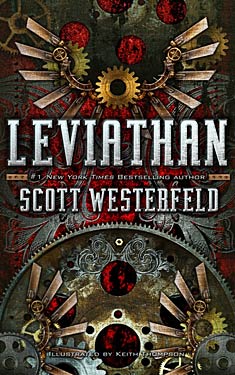 Leviathan by Scott Westerfeld
Leviathan by Scott Westerfeld
Published: Simon Pulse, 2009
Series: Leviathan Series: Book 1
Awards Won: Locus Young Adult Award 2010
The Book:
"It is the cusp of World War I. The Austro-Hungarians and Germans have their Clankers, steam-driven iron machines loaded with guns and ammunition. The British Darwinists employ genetically fabricated animals as their weaponry. Their Leviathan is a whale airship, and the most masterful beast in the British fleet.
Aleksandar Ferdinand, a Clanker, and Deryn Sharp, a Darwinist, are on opposite sides of the war. But their paths cross in the most unexpected way, taking them both aboard the Leviathan on a fantastical, around-the-world adventure…. One that will change both their lives forever." ~barnesandnoble.com
Scott Westerfeld is a well-known name in young adult fiction, though up until now I’d never read any of his work. In honor of WWEnd’s “Young Adult Genre Fiction” month, I’m reviewing his most recent series, which starts with Leviathan. Leviathan had a satisfying ending, to my mind, but it is clearly the first part of a larger story. The final volume of this series, Goliath, came out this past September, so I’m looking forward to being able to read the complete trilogy, uninterrupted!
My Thoughts:
Leviathan is a non-stop adventure that spans several European countries. While it takes place during the start of World War I, many aspects of Westerfeld’s world differ from reality. The most notable difference, of course, is the presence of fantastical technology. The Clankers have powerful, steam-powered walkers, and the Darwinists have amazing animals fabricated from the ‘life strings’ of many different species. These animals range from messenger lizards, to jellyfish-based airbeasts, to complicated floating ecosystems like the Leviathan airship of the book’s title. Westerfeld spends a lot of time describing his imaginative creations, and they are also brought to life by Keith Thompson’s many beautiful illustrations (like the example map in the header above).
While the technology is a major selling point of the story, Leviathan also features two engaging protagonists. Alek Ferdinand (yes, that Ferdinand) is an aristocratic Clanker fugitive with a huge secret. His parents made sure he was trained in mechaniks, swordfighting, and many languages, but he still has no idea how to deal with the world outside his family’s estate. Deryn Sharp has a pretty major secret of her own—she’s joined the British military as a midshipman, posing as a boy. Deryn mostly manages to keep everyone convinced of her gender through force of personality. Her never-ending exuberance and boyish swagger make it seem like her life has always been a jump from one adventure to the next. Deryn and Alek are opposites in many ways, though they are both fallible teenagers in the middle of very dangerous situations.
Though Deryn and Alek are exciting characters to follow, they seem to be written a little younger than their supposed age. If the book had not specified that they were fifteen, I would have estimated an age of twelve or thirteen. Even in the many illustrations, they appear to be shown as pre-teens, not teens. In general, I would say that is in line with the targeted demographic, which I would guess to be middle schoolers (about 12-14 years old). This guess is based on the reading level, the portrayal of the protagonists, and the amount of questionable content (very little, save for a few potentially frightening battle scenes). I don’t mean to say that someone older couldn’t enjoy it—I’m over a decade past that age group, and I still thought Leviathan was a lot of fun.
Aside from the constant thrills of the story, Leviathan is also concerned with portraying the interconnectedness of living systems. One example of this can be seen in the Leviathan airship itself. In addition to the hydrogen-filled whale-like creature that makes up its main body, the Leviathan’s life and health rely on an ecosystem made up of birds, bats, bees, bacteria, curious hydrogen-sniffing animals, and many others. If any one of the pieces of this system is missing, it will have disastrous effects on the whole.
 The Leviathan airship is also controlled by Captain Hobbes, which makes it a fairly clear reference to Thomas Hobbes’s famous work of the same name. Hobbes’s work is an early example of social contract theory, and it describes an ideal government as a kind of enormous, complex creature composed of its living members. The themes of interdependence and cooperation are also repeated in various ways through the political discussions and actions of the novel. While Leviathan is entertaining as an adventure story, there’s also plenty of discussion material for those who want to look beneath the surface.
The Leviathan airship is also controlled by Captain Hobbes, which makes it a fairly clear reference to Thomas Hobbes’s famous work of the same name. Hobbes’s work is an early example of social contract theory, and it describes an ideal government as a kind of enormous, complex creature composed of its living members. The themes of interdependence and cooperation are also repeated in various ways through the political discussions and actions of the novel. While Leviathan is entertaining as an adventure story, there’s also plenty of discussion material for those who want to look beneath the surface.
My Rating: 4/5
Leviathan is an exciting, action-packed steampunk re-imagining of World War I, with fantastic technology that is brought to life through Keith Thompson’s frequent illustrations. Though the protagonists, Alek and Deryn, seem younger than their fifteen years, they are engagingly intelligent and resourceful protagonists. Leviathan also contains a subtext about the interdependence of living systems and the necessity of cooperation, making it a book worth discussion. I’m starting Behemoth now, and I can’t wait to see what happens next!
Recently Read Books in Brief
I’ve been doing a lot of reading lately, but haven’t had enough to say about each book to warrant a full-size review. Instead I’ve decided to write short capsule reviews for each.
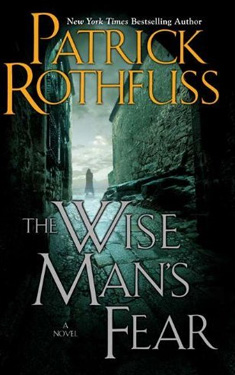 The Wise Man’s Fear, by Patrick Rothfuss
The Wise Man’s Fear, by Patrick Rothfuss
There’s a lot to love in the latest installment of Rothfuss’s Kingkiller Chronicles, and I have to disagree with the fans who complain that the quality isn’t worth the wait. Good art is always worth the wait, and genre fiction is too often hurt by publishers who rush their authors into producing sequels. As one of his characters observes in regards to music, “Songs choose their hour.” Orson Scott Card described the series as “Harry Potter for Grownups,” but frankly the comparison would never have occurred to me; the University across the river from Rothfuss’s fictional Imre actually teaches real-world subjects, with the magical subjects slowly falling into disuse. The continuation of Kvothe’s story sees him traveling the world and growing in experience if not wisdom. Being a polymath, Kvothe picks up academic learning very quickly, and he is also apparently as physically adept as he is intellectually. He also makes a good deal of progress in sniffing out the origin and identity of his parents’ killers, setting up the Chronicler (and the reader) for the final installment of the series.
Not to say that everything is perfect with the novel. The sexual content is graphic when a more modest approach would have served as well if not better, sometimes veering into the realm of the perverse. Rothfuss also introduces an antagonist who is so unbelievably powerful and malevolent that he seems far too large for this story, especially being introduced halfway through the story. The character Denna is too unlikeably distant for the reader to sympathize with, though it’s understandable that Kvothe would admire her as an unattainable prize.
Still, this is a good read, and much better than what one usually finds in the fantasy genre, even from established writers. I look forward to the next volume in, say, 2014?
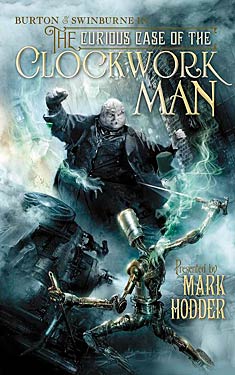 The Curious Case of the Clockwork Man, by Mark Hodder
The Curious Case of the Clockwork Man, by Mark Hodder
I’ve never felt a great draw to the Steampunk genre, but Hodder is knowledgeable enough about the Victorian era that he can create an alternate version of that era which feels as rich and complex as the real thing. Unfortunately he does so by means of time travel. I realize I’m in the minority of WWEnd members when I complain about the inherent illogic of time travel and wish it were purged from all media, but I’ve learned to live with the fact that most other people love it. As mentioned in my review of the first book, The Strange Affair of Spring Heeled Jack, Hodder uses the time travel as something of a gimmick to get things rolling, and I was hoping that in the sequels it simply wouldn’t be brought up again. Not only does time travel occur in Clockwork Man, but it does so in ever-nonsensical ways. The explanation for why things like occult powers and quick-and-easy genetic manipulation work is also somewhat belabored and silly.
Burton and Swinburne themselves are in top form, and as entertaining as ever. Their supporting cast grows noticeably in these pages, despite a number of bloody deaths, still for the most part using real historical personages in the fictional milieu. Hodder lets things become a little too chaotic by the time London starts to burn, introducing zombies, ectoplasmic houses and mad Russian monks before the story is through. One puts down the book wishing for a little more thematic unity.
Personally, I think I’m through with this series. Hodder seems overly anxious to toss in as many popular tropes as he can think of, while sidelining the characters a little too much. Frankly, I find the characters far more interesting than a mind-controlled corpulent cannibal fighting a robot with a sword (see the cover to the left). All the best to Mr. Hodder on his series, but I will have to pass on it.
Joe Hill, the son of horror master Stephen King, has written a great little novel that is both frightening and down to earth in its characterizations. The protagonist is aging rock star Judas Coyne, who is a collector of both morbid artifacts and lovers. Upon hearing of the sale of a dead man’s ghost on an auction site, he decides he must win the auction. Once the heart-shaped box arrives in the mail, the horror begins.
This is, I believe, Hill’s first novel, but it does not feel like an amateur story. He has a less florid style than his father, slightly less insane ideas, and a rather more hopeful approach to his characters and their fates. The pace is quick even when the characters stay in one place, and the prose is more than competent. The story has enough twists to keep you guessing at what will happen next, and just like any good horror story it has a few images that will haunt your nightmares.
All in all, a good read. Hill doesn’t break any new ground that I can tell, but it’s still worth the time.
The Strange Affair of Spring Heeled Jack
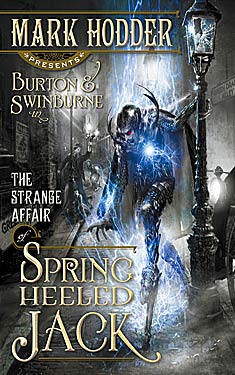 [There are spoilers throughout. This novel is difficult to review without referencing certain events in the story. In my defense, many of the later twists are strongly foreshadowed early on. Also, a special thanks to Pyr Books for providing WWEnd with a review copy of this book.]
[There are spoilers throughout. This novel is difficult to review without referencing certain events in the story. In my defense, many of the later twists are strongly foreshadowed early on. Also, a special thanks to Pyr Books for providing WWEnd with a review copy of this book.]
Mark Hodder’s inaugural novel neatly rides the popular wave of pseudo-Victorian Steampunk while mixing in well-worn science fiction tropes like time travel and genetic engineering. It’s obvious Hodder has done his homework, as his depiction of the Victorian era is very detailed, both in its representation of the society as it actually was and in the minor and major changes that have taken place as a result of a time travel incident. It’s like reading a Dickens novel with ray guns.
The novel’s protagonist is Richard Burton, who in real history was something of a failed explorer (he made an early attempt to find the source of the Nile), a maligned statesman (tossed about from one consulship to another in later life) and a bit of a pervert (the least offensive thing he did was to be the first to translate the Kama Sutra into English). The main crux of the novel hinges on the fact that Burton’s career makes a major turn to the better when he is hired to investigate the mysterious Spring Heeled Jack by special assignment of the Prime Minister. In this new timeline Burton feels that he barely escaped a horrible fate, validated during a collision with the aforementioned Jack, who tells Burton that nothing is as it ought to be.
Burton’s partner, the story’s secondary protagonist, is the minor poet Algernon Charles Swinburne. He’s quite the opposite of Burton in many ways—short, thin, unathletic, somewhat effeminate—but he seeks the sort of life-threatening adventure that he feels is necessary to make his poetry great. That and the fact that he can easily disguise himself as a young chimney sweep gradually makes him an indispensable partner to Burton’s investigation.
These two adventurers live in a world where Queen Victoria was assassinated on the same day Spring Heeled Jack was first spotted; a world in which the eugenics movement has progressed so far that super-intelligent dogs and birds act as message carriers; a world in which geothermal energy is tapped as a sustainable manner; a world in which cats act as living vacuum cleaners; a world where human brains can be transplanted into animal bodies and even into other human bodies to make double-brained beings; a world in which helicopter-like machines are common and genetic werewolves haunt the lower-class neighborhoods. This is the novel’s biggest draw but also, I would argue, its major weakness, for it all hinges on the changes caused by one time traveler from the twenty-second century who effects all these changes simply by feverishly talking about the scientific wonders of the future to one man who happens to be well-connected. None of his own technology is reverse-engineered; apparently all that was needed to make all these changes happen in a few decades was to plant the ideas in a few minds. (The time travel logic itself is also very convoluted and self-contradictory. Badly written time travel always throws me out of the story while simultaneously giving me a headache.)
The plot revolves around a group of scientists attempting to perfect their social and genetic engineering plans. They want to create a perfect world, and they aren’t afraid of murdering and causing widespread grief to bring this world about. This isn’t the strongest aspect of the novel, which excels in describing its imaginative alternate England and the antics of its protagonists, but the worst that can be said of the plot is that it’s just there to give our heroes something to do. One hopes that, now that the origin story is out of the way, the Burton and Swinburne team can proceed with their adventures without going through the motions of explaining why their world is the way it is. Honestly, the less time spent on that explanation the better, because it simply doesn’t hold up to scrutiny.
Burton’s major decision at the very end is amazingly cold-blooded and clearly defines his character as an anti-hero of ambiguous moral status. Even his fiancée Isabel is a clearly drawn character who could probably support a novel of her own. Swinburne is somewhat less defined since the novel follows Burton’s point of view almost exclusively, but one hopes that future installments will spend more time with Swinburne and his poetic response to the strange world in which they live. Hodder’s sequel The Curious Case of the Clockwork Man is due out this March, and this reader is definitely looking forward to seeing where he goes with the series.
Boneshaker – A rootin’, tootin’, zombie-shootin’ good time.
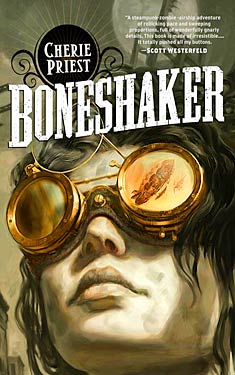 Let me start by saying, I am not a Steampunk aficionado, nor am I well acquainted with the average plots and ambient intentions for that particular sub-genre. But, I do know good fiction. And Boneshaker, by Cherie Priest, (2009 Nebula Award nominee, 2010 Hugo and Locus SF Awards nominatee) is good fiction.
Let me start by saying, I am not a Steampunk aficionado, nor am I well acquainted with the average plots and ambient intentions for that particular sub-genre. But, I do know good fiction. And Boneshaker, by Cherie Priest, (2009 Nebula Award nominee, 2010 Hugo and Locus SF Awards nominatee) is good fiction.
Steampunk, over-simplified, is science fiction Victoriana, or in this case, science fiction set in the Old West. It combines Science Fiction devices and themes with an affection for nineteenth century settings and adds an elusive third element of the macabre, or decadence, or daring do. "Boneshaker" succeeds, as a story, for two reasons. It doesn’t over-sell the setting, and it tells a rip-roaring adventure story. I was surprised to find I liked it as much as I did. And like it I did, by crackey.
The setting is an alternate reality Seattle in the 1870’s. The city has been devastated, and transformed, by an industrial accident of epic proportions. The city itself is walled off, and a toxic gas with strange properties ebbs out of the ground on the site of the accident itself. Outside the city, the United States still struggles with the Civil War, and the settlement of the West proceeds haltingly. Around the city, residents have come to terms with the wall, and the gaseous zombie state within it. All save one… one young buckaroo isn’t happy home on the range, and goes over the wall (actually, under it) in search of adventure.
His ma reacts like any ma would… lock and load, hit the road, she heads into the walled-off city to find her boy. The story carouses through underground engine rooms and pirate airships and line-’em-up-at-the-bar saloons, picking up speed until, before you know it, you, dear reader, are drooling on the pages like one of the many, many zombies that chase our heroes around the city.
Suffice it to say, if you’ve never felt the peculiar, absinthe rush-like urge to grab a Steampunk tale, this is a good one to start with. And if you’ve already got top hats and monocles and claws and fishnet and, um, other things hanging in your closet already, put this one on your list. It’s a rootin’, tootin’, zombie-shootin’ good time.
Boneshaker is published by Tor Books, out now in Trade Paperback.



















 Full Details
Full Details
